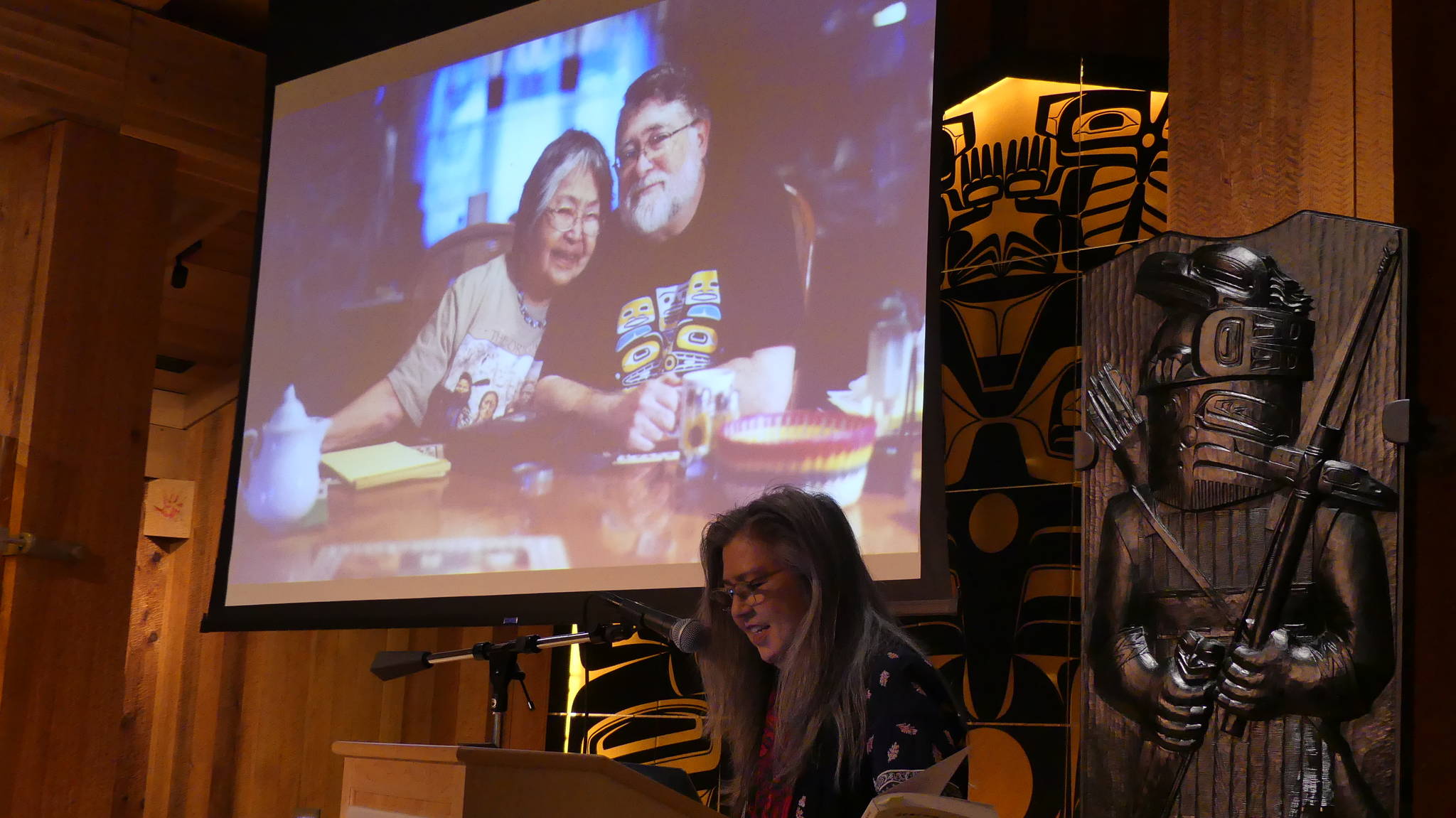Within the adzed, cedar walls of the Shuká Hít (clan house) in Sealaska Heritage Institute’s Walter Sobeloff Building, Vivian Mork introduced herself and her family lineage in both Tlingit and English to reflect the influence Nora Keixwnéi Marks Dauenhauer had on her life. Dauenhauer passed away last year at the age of 90.
“What I loved about Nora, and one of the things she taught us with introductions, is that we are giving respect to all the people who came before us and made a place for us in this world, and that she did,” Mork said.
Celebration 2018’s theme “Respect: Weigh Your Words” inspired Tlingit-Tsimshian poet Donna Beaver to organize Alaska Native poetry performances by Robert Davis Hoffmann, Ishmael Hope, Vivian Mork, and Beaver herself at the Shuká Hít this past Friday. The performances served as a verbal homage to poets and scholars like Nora and Richard Dauenhauer, Jim Schoppert, Andy Hope, Sherman Sumdum, and Clarissa Rizal who sparked what some referred to as a literary renaissance for Alaska Natives.
Growing up in Wrangell, Mork said there were no fluent Tlingit speakers around her to learn the language from but there was “Beginning Tlingit,” a textbook written by Nora and Richard in the 1970s, which included audio cassette tapes to play while reading the text.
“I would listen to (the tapes) all the time when I was little and look at the books, and then someone stole the tapes and they didn’t replace them so there were only the books and it’s really hard to get ‘hssst’ off the paper.” That is, it is hard to correctly pronounce Tlingit if it has never been heard before.
In Alaska and beyond, the Dauenhauers are held in high regard for their research and publications of Tlingit oral narratives and life stories. Sitting in the audience that night was University of Alaska Chancellor Rick Caulfield who commented on Nora and Richard’s contributions.
“There are not so many fluent speakers left, so capturing that knowledge, wisdom, poetry, and stories and putting them into writing so they can be shared with the next generation is really important work to do,” Caulfield said. “She and her husband did a tremendous service to all of us in making those wonderful stories accessible to people.”
Rhonda Mann, who performed a few of Nora’s pieces on Friday, said right out of college she began working with the Dauenhauers on the publication of their books, held and transcribed interviews with elders, and helped create the Tlingit typeset so that the oral language, complex in tones and guttural sounds, could persist in text form.
“Our stories, our speeches, our languages — it is pretty much pure poetry,” Mann said. “If you listen to the songs, to a story being told from an elder, it is pure poetry. It’s in phrases, there are long pauses to allow the person speaking to think and be careful in what they say and how they say it, and it also allows the listener to really hear and envision what they’re saying. It’s a way of speaking, living, and communicating.”
Event organizer Donna Beaver emphasized that Tlingit people have created short forms of poetry similar to haikus for thousands of years and that in the past, the clan house served as more than just a place to rest and live out daily life.
“You had a big fire pit that’s practically burning into the rooftops here and they (built the floor plan) in these layers here so that the kids and grandparents could all sit here and be on their mats lying down,” Beaver said. “Then some people would be up here singing, dancing, and storytelling. We were way beyond our time — we were doing Broadway before Broadway.”
Beaver shares that Alaska Native people gravitated towards poetry because of its similarity to the storytelling nature already present within Alaska Native languages. In Southeast, Nora, Richard, and Robert Davis Hoffmann were the ones that kicked off the big poetry movement in the 1980s, Beaver said. In the four or so decades since then, Beaver has noticed one big change within the Alaska Native poetry world.
“The one thing I’m seeing more of is incorporating the language (itself) into the poetry,” Beaver said. “We also incorporate our uses of the land and sharing some of that knowledge through the poetry.”
Twenty-first century technology has now made the accessibility of Alaska Native stories and languages quick to take in for eager learners. Videos of Nora reading poetry are available online if you type her name into Youtube’s search engine, while a phone app called “Chert” can be downloaded to add a keyboard to your cell phone so you can text in all 20 Alaska Native languages. Before the incorporation of the illuminated screen’s instant plays and downloads though, it is important to remember people like Nora who diligently used pens and paper, audio cassette tapes, and bravery as she listened to voices alive with knowledge and transcribed them down to the page so that the stories could persist even when the people telling them could not.
• Ray Friedlander is a freelance writer living in Juneau.

